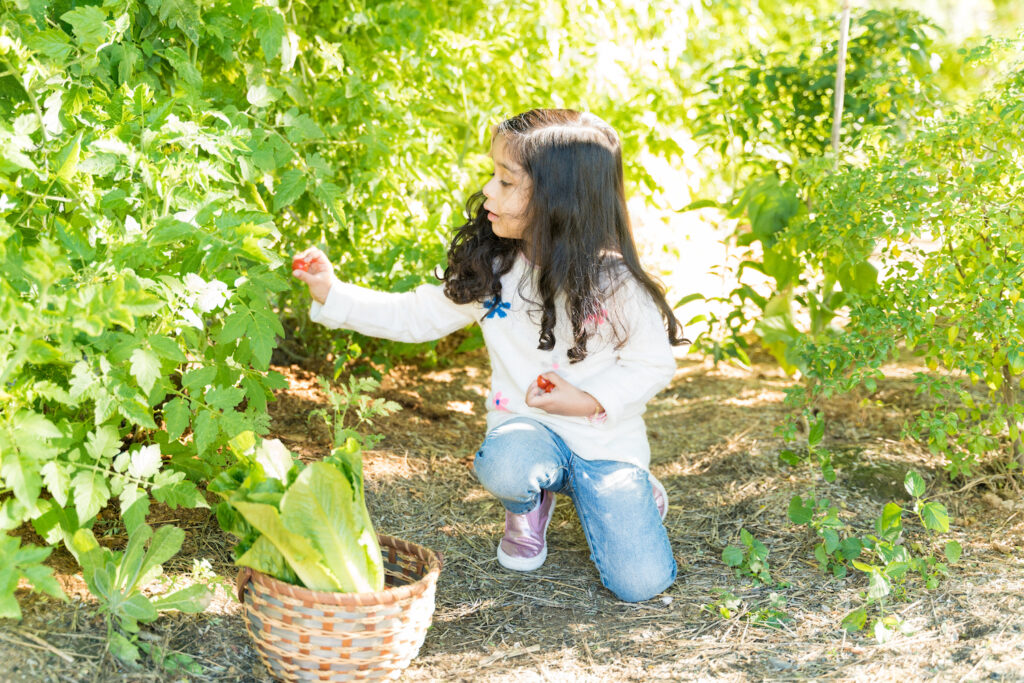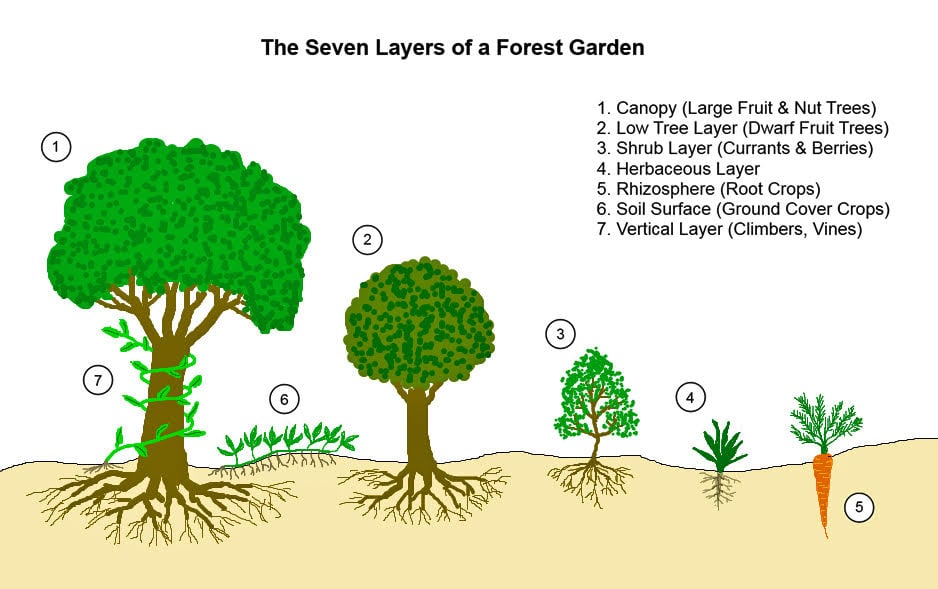Food Forests: How To Plan a Family-Friendly Forest Garden
The ingredients are simple: plants, soil, seeds, sun, a sprinkle of rain, a bit of mulch, and a piece of land (it needn’t be large: your backyard – or even a portion of it – will do.)
The result? A magical food forest of abundance that will sustain your family in body, mind and spirit, for all the years of their childhood and beyond.

Food forests are – pardon the pun – a fast-growing trend all over the world. Let’s take a closer look at why so many homeowners are choosing to turn their lawn into a food forest, why this approach to landscape is especially good for kids, and how to get one growing in your backyard.
Table of contents
What Is a Food Forest?
A food forest, or forest garden, is edible landscaping designed using the principles of permaculture.
Permaculture is a holistic approach to landscape and food production. Rather than seeking to dominate nature, permaculture is based on observing, emulating, and enhancing natural ecosystems and processes.
Permaculture principles can be used to design any landscape from a small urban yard to a full-scale farm. There is even mounting evidence that large portions of the Amazon rainforest – known to be one of the most productive landscapes on Earth – may have been intentionally designed by humans to be food-producing regions. And in fact, many permaculture practices have their roots in indigenous wisdom from around the world.
Why Plant A Backyard Forest Garden?
Children have become the unintentional “canary in the coal mine” of a world so focused on short-term survival that we’ve forgotten what it means to be stewards of our own wellbeing, let alone that of the planet.
Study after study has shown that kids need time in nature. But sadly, today’s children spend less time outdoors in natural settings than ever before. “Nature deficit disorder” is taking its toll in skyrocketing levels of childhood depression, anxiety, obesity, attention difficulties, and other physical and mental disorders.
Central to this problem is that it can be incredibly challenging for today’s parents to find safe opportunities to get their kids into nature while juggling work, school, soccer games, and all the other demands of modern family life.
Enter the backyard food forest.
Edible landscaping offers an abundance of benefits for families, including:
- Clean, healthy food
- Sanctuary space for improved mental and emotional health
- Hands-on, immersive learning
- Safe, naturally stimulating play area
- Habitat for pollinators and wildlife
- Improved soil
- Erosion and runoff control
- Beautiful, low-maintenance landscape
- Food security
- Financial payback
Planting a food forest with your family may seem like a simple activity. But it has the potential to be profoundly life-changing in ways that may take generations to fully realize. Food forests literally contain the seeds of a new paradigm for how humans can live in harmony with the earth.
“There’s something magical about our connection to the natural system, and we’ve gotten so disconnected with that,” says Jim Gale, founder of Food Forest Abundance, a global permaculture cooperative whose vision is to see food forests growing in every community and yard around the world.
“The idea of the abundance of the Garden of Eden is not a utopian fantasy. It’s literally the next logical step for humanity…Gardening or growing food is the act of the ultimate revolution. The re-evolution of our society, literally, it’s that simple.”
Planning Your Family Friendly Food Forest
Planning is the first, crucial step towards a successful food forest. You can plan a food forest any time of the year. Many perennials can be planted in late summer or early fall, for a head start on next year’s growing season. Or, lay out your beds this fall and plant in the spring.
Mindful planning takes into account the needs of both plants and people. If you are planning a food forest with children in mind, there are a few things to think about that adults may overlook.
Safety Matters
Safety is always a primary concern when designing child-friendly spaces. Deciding what is safe and what isn’t is often a matter of considering the age of your children and potential guests, as well as the level of supervision you expect to provide. For example, a water feature may be a delightful addition to your forest garden, but keep in mind that even a small one may pose a drowning risk for an unsupervised toddler.
One safety feature that is appropriate for any age group is a sturdy fence. Research has shown that children given a fenced-in playground feel safer to play and explore freely. Fences are also a great design feature because they provide structure for vining plants – one of the important elements in a permaculture garden!

Plant toxicity is another thing to consider. Some food plants, such as rhubarb, have toxic parts. Others, like parsnip or nettles, can cause reactions on sensitive skin. Doing your research or consulting with an expert permaculture designer can help you avoid these plants altogether and/or teach your children to treat them with respect.
How to Choose Edible Landscaping Plants For Your Forest Garden
Permaculture food forests depend primarily on perennial plants that come back year after year. This approach helps to build rather than deplete soils. It’s also a lot less work over time because it eliminates the need to till the soil every year!
A fully developed food forest contains up to 7 plant layers. These include “guilds” of different types of plants from tall trees and plants to ground covers which grow well together and support each other synergistically in the garden.
The 7 layers of a permaculture food forest or forest garden include:
- Canopy layer – large fruit trees or nut trees, typically 30 or more feet tall. Smaller backyards might omit this layer or might use a taller subcanopy tree such as standard apple trees in its place. Examples may include walnut, avocado, mulberry, or stone pine.
- Sub-canopy layer – shorter fruit or nut trees such as apple, peach, pear, or hazelnut.
- Shrub layer – this layer includes food-bearing shrubs and bushes such as raspberries, blueberries, or hazelnut. Many lesser-known shrubs are also available that make excellent shrub layer additions, such as sea buckthorn, serviceberry, honeyberry, goji berry, and Nanking cherry.
- Herbaceous layer – typically, herbaceous plants consist of non-woody food or medicinal plants, many of which may die back in winter or during dry spells. Examples include asparagus, Good King Henry, hosta, comfrey, and many of the culinary herbs such as oregano and mint.
- Ground cover layer – These are plants that grow densely together to cover the soil. Often they are shade tolerant and grow under the taller layers. Examples include creeping thyme, periwinkle, and strawberry. There can be some overlap between this and the herbaceous layer, so plants like hosta or mint might fulfill both functions.
- Root layer – While technically nearly every plant contributes to the root crops layer of your forest garden, certain plants have roots or tubers with food or medicinal value. Some examples of root layer food forest plants include wild leek, ginger, ginseng, cassava, and Jerusalem artichoke.
- Climbing layer – This includes vines and climbing plants such as grapes, hardy kiwi, or hops.

Image via Elemental Green
Annuals also have their place in a food forest garden, especially in the first years when your perennial plants are still getting established. Tuck in annual vegetables alongside your trees and shrubs, let pole beans or cucumbers climb over your woody plants, or dedicate a sunny area of your food forest to raising your family’s favorite veggies.
Pollinator garden plants also make great additions to your food forest.
Choosing the right permaculture plants for your site depends on many factors, including climate, soil type, hours of sunlight available, your family’s preferences, etc. When selecting food plants for your forest garden, consider what your family will actually eat.
Experiment with new things but be sure to include plenty of native plants and tried-and-true favorites as well. Consulting a certified permaculture designer can be extremely helpful in determining which plants and in what combination will be most suited to your site and your needs.
UK-based pioneer of forest gardening, Martin Crawford started with a flat field in 1994. Since then he has transformed it into a woodland with more than 500 varieties of food growing wild in his garden, which requires very little work other than plucking and eating the fruits of his “labor.” It also serves as an educational resource for others interested in forest gardening.
The Incredible Edible Landscape: A Place to Explore
A well-planned, child-friendly food forest can entice kids to unplug and explore the world around them, as nature meant them to do! Here are some ideas you may like to incorporate into your food forest to encourage kids to play, learn, and explore in a forest garden:
- Choose plants that delight the senses. Look for a variety of colors, flavors, textures, and scents unfolding throughout the season.
- If you have the space, include a bit of open area for kids to stretch out and run, as well as spots to hide.
- Consider adding a sensory play area with different materials for kids to play with, such as sand and potting soil. Water play is always a big hit, too.
- Animals and kids are a natural fit. If you have the space and time to care for them, you can include small animals such as chickens or rabbits in your food forest. If not, you can still include animals in your system by encouraging wildlife to visit and stay. Kids love to help build bird and bat houses, or set up a toad house by propping up a garden pot. You can plant pollinator favorites like milkweed to attract bees and beneficial insects or plant a few extra heads of lettuce for your wild rabbit friends.
- Give your child a little plot of ground to call their own. Rather than telling them what to do with it, let them take the lead. Whether they create a mud pie factory, a dancing stage, or a lush little garden of their own, appreciate how each child expresses their unique personality through their relationship with the land.
Sanctuary Space for Kids
The adults and older teens in your family may appreciate a meditation nook or fire pit to hang out with friends. But kids can have very different needs when it comes to how they use a space to relax.
A forest garden offers ample opportunity to incorporate hidey places that make children feel at home. These could be temporary structures such as a sunflower house, or more permanent spaces such as an arbor or a clearing inside a circle of shrubs.
Many edible shrubs will create thickets if allowed to grow freely, and children will naturally carve out forts and shelters within them. Or, help your child create a fairy garden or a playhouse for their dolls and toys.
If you are lucky enough to have climbable trees in your yard, that’s a great start – just be sure to teach your kids to respect both heights and the tree. Adding a climbing structure such as a tree house, play house, rope swing, or monkey bars will satisfy their need to climb and swing around.
Trees are fun for kids. And they also protect delicate edible plants from the elements and extreme weather. They can also provide nutrients, water, and pest control, and they can help with pollination.
The Future of Your Edible Forest Garden
When planning a backyard food forest, think about your family’s current needs and those over the course of the next decade or two.
Children’s needs change as they grow. A five-year-old may be happy making mud pies all day, but a teenager? Probably not. Because a permaculture garden relies largely on perennial plants that grow over time, you’ll want to take some time to envision how the space will change over time, and how you might begin to use the garden differently as your kids grow up.
One of the best ways to do this is involve the whole family in the planning process.
Planting Your Backyard Food Forest
Transforming your backyard into a food forest ecosystem can be as hands-on or hands-off as you like. You can plant everything yourself or hire someone else to do the “dirty work.”
Spend time observing the space. Don’t cut down any tall trees unless they’re diseased or they block all the sunlight from a space you’d like to use as your main garden. Which plants require partial shade? It can be a good idea to keep these canopy trees as part of your self-sustaining ecosystem.
For most yards, planting a food forest means converting grassy lawn into perennial garden beds. One of the easiest ways to do this is to use the lasagna gardening method. This no-till method uses natural materials such as leaves, straw, compost, and manure to create a deep, fertile planting bed without having to strip out turf or turn heavy soil.
How to Grow a Food Forest
To create a lasagna bed for your food forest garden:
- Soak the area thoroughly. If the rain doesn’t bless you at the right time, use a sprinkler.
- Lay down a layer of cardboard or a thick layer of wet newspapers over the entire area to suppress grass re-growth. (If you are morally opposed to using paper products on your garden bed you can omit this if you use thick enough mulch layers. However, you may be surprised at how tenacious grass can be at finding its way through!)
- Layer on a 1-2 inch “green layer” of nitrogen-rich material such as grass clippings, manure, kitchen scraps, garden trimmings, coffee grounds, compost, etc.
- Lay down a 2-3 inch “brown layer” of carbon-rich mulch material. This can be old leaves, straw, shredded newspaper, pine needles, peat moss, fine wood chips, etc.
- Continue layering alternate layers until you have a bed 6” or more high. It’s best to top with a mulch layer to keep it looking tidy.
It takes a few weeks, but all the built-up material will smother the grass and start to break down into rich soil for your plants. If you are planning to plant seeds or seedlings, you can actually plant after only a couple of weeks.
Top the whole bed with 1-2 inches of good soil or compost and plant right into that. If planting larger plants, you may need to clear away some of the material first or even dig down through the cardboard. If that is the case, it’s wise to wait a few extra weeks until your grass is fully dead before planting.
Most kids love to be involved in helping build and plant the beds. Be sure to give them age appropriate tasks, praise them for their effort, and stay excited about all the good things to follow from the work your family is doing today!
Food Forest Resources
If you’ve read this far, you’re probably feeling pretty excited about what a productive food forest could do for your family. If that’s the case, you most likely are feeling one of three ways:
- Ready to take on the world: You’re a gardening pro (or at least know how to plunk a few plants in the ground and get them to live.) You love to do things yourself and learn along the way. Just point you in the right direction and you’ll get your backyard food forest up and running from there!
- Cautiously optimistic: A backyard forest garden sounds totally do-able and you love the idea of low-maintenance abundance. But, you would feel a lot more confident knowing you’re doing it right. Having a plan in place and maybe someone who knows what they’re doing to guide you would be an ideal place to start!
- Just give me the results. You totally want to enjoy the fruits, but frankly you don’t want to get your hands dirty. You’d rather spend the time playing with your kids than having to pore through garden catalogs looking for the perfect plants. If you can find someone to plan and put the whole thing in for you, you’ll be happy as a clam!
Whatever your inclination, it’s important to realize that there’s more to planting a food forest than just throwing a bunch of plants in the ground. While we covered some of the basics, permaculture design covers so much more than one article could ever address. The good news is that whichever of the above personas you identify with, support is there for you!
Whether you are a die-hard do-it-yourselfer or someone who just wants it done for you, consider taking a little time to check out sites from permaculture experts like Permaculture Institute or Food Forest Abundance.
Tapping into that knowledge base will give you a better understanding of what permaculture is and the incredible potential it has to create positive change for your family and for society as a whole. They will also help you find the resources you need to greatly improve your edible landscaping experience.
Whether it be permaculture how-to videos, blueprint design, a local installer, or even permaculture design certification, with a little “digging” you will certainly find the right resources to help you create a family friendly food forest your kids will enjoy, remember, and talk about for the rest of their lives!
